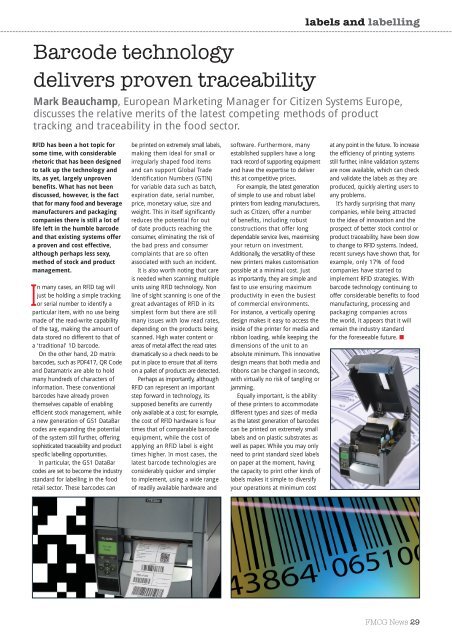LABELS AND LABELLING - Onecoms.co.uk
LABELS AND LABELLING - Onecoms.co.uk
LABELS AND LABELLING - Onecoms.co.uk
You also want an ePaper? Increase the reach of your titles
YUMPU automatically turns print PDFs into web optimized ePapers that Google loves.
Bar<strong>co</strong>de technology<br />
delivers proven traceability<br />
RFID has been a hot topic for<br />
some time, with <strong>co</strong>nsiderable<br />
rhetoric that has been designed<br />
to talk up the technology and<br />
its, as yet, largely unproven<br />
benefits. What has not been<br />
discussed, however, is the fact<br />
that for many food and beverage<br />
manufacturers and packaging<br />
<strong>co</strong>mpanies there is still a lot of<br />
life left in the humble bar<strong>co</strong>de<br />
and that existing systems offer<br />
a proven and <strong>co</strong>st effective,<br />
although perhaps less sexy,<br />
method of stock and product<br />
management.<br />
In many cases, an RFID tag will<br />
just be holding a simple tracking<br />
or serial number to identify a<br />
particular item, with no use being<br />
made of the read-write capability<br />
of the tag, making the amount of<br />
data stored no different to that of<br />
a ‘traditional’ 1D bar<strong>co</strong>de.<br />
On the other hand, 2D matrix<br />
bar<strong>co</strong>des, such as PDF417, QR Code<br />
and Datamatrix are able to hold<br />
many hundreds of characters of<br />
information. These <strong>co</strong>nventional<br />
bar<strong>co</strong>des have already proven<br />
themselves capable of enabling<br />
efficient stock management, while<br />
a new generation of GS1 DataBar<br />
<strong>co</strong>des are expanding the potential<br />
of the system still further, offering<br />
sophisticated traceability and product<br />
specific labelling opportunities.<br />
In particular, the GS1 DataBar<br />
<strong>co</strong>des are set to be<strong>co</strong>me the industry<br />
standard for labelling in the food<br />
retail sector. These bar<strong>co</strong>des can<br />
be printed on extremely small labels,<br />
making them ideal for small or<br />
irregularly shaped food items<br />
and can support Global Trade<br />
Identification Numbers (GTIN)<br />
for variable data such as batch,<br />
expiration date, serial number,<br />
price, monetary value, size and<br />
weight. This in itself significantly<br />
reduces the potential for out<br />
of date products reaching the<br />
<strong>co</strong>nsumer, eliminating the risk of<br />
the bad press and <strong>co</strong>nsumer<br />
<strong>co</strong>mplaints that are so often<br />
associated with such an incident.<br />
It is also worth noting that care<br />
is needed when scanning multiple<br />
units using RFID technology. Non<br />
line of sight scanning is one of the<br />
great advantages of RFID in its<br />
simplest form but there are still<br />
many issues with low read rates,<br />
depending on the products being<br />
scanned. High water <strong>co</strong>ntent or<br />
areas of metal affect the read rates<br />
dramatically so a check needs to be<br />
put in place to ensure that all items<br />
on a pallet of products are detected.<br />
Perhaps as importantly, although<br />
RFID can represent an important<br />
step forward in technology, its<br />
supposed benefits are currently<br />
only available at a <strong>co</strong>st; for example,<br />
the <strong>co</strong>st of RFID hardware is four<br />
times that of <strong>co</strong>mparable bar<strong>co</strong>de<br />
equipment, while the <strong>co</strong>st of<br />
applying an RFID label is eight<br />
times higher. In most cases, the<br />
latest bar<strong>co</strong>de technologies are<br />
<strong>co</strong>nsiderably quicker and simpler<br />
to implement, using a wide range<br />
of readily available hardware and<br />
software. Furthermore, many<br />
established suppliers have a long<br />
track re<strong>co</strong>rd of supporting equipment<br />
and have the expertise to deliver<br />
this at <strong>co</strong>mpetitive prices.<br />
For example, the latest generation<br />
of simple to use and robust label<br />
printers from leading manufacturers,<br />
such as Citizen, offer a number<br />
of benefits, including robust<br />
<strong>co</strong>nstructions that offer long<br />
dependable service lives, maximising<br />
your return on investment.<br />
Additionally, the versatility of these<br />
new printers makes customisation<br />
possible at a minimal <strong>co</strong>st. Just<br />
as importantly, they are simple and<br />
fast to use ensuring maximum<br />
productivity in even the busiest<br />
of <strong>co</strong>mmercial environments.<br />
For instance, a vertically opening<br />
design makes it easy to access the<br />
inside of the printer for media and<br />
ribbon loading, while keeping the<br />
dimensions of the unit to an<br />
absolute minimum. This innovative<br />
design means that both media and<br />
ribbons can be changed in se<strong>co</strong>nds,<br />
with virtually no risk of tangling or<br />
jamming.<br />
Equally important, is the ability<br />
of these printers to ac<strong>co</strong>mmodate<br />
different types and sizes of media<br />
as the latest generation of bar<strong>co</strong>des<br />
can be printed on extremely small<br />
labels and on plastic substrates as<br />
well as paper. While you may only<br />
need to print standard sized labels<br />
on paper at the moment, having<br />
the capacity to print other kinds of<br />
labels makes it simple to diversify<br />
your operations at minimum <strong>co</strong>st<br />
labels and labelling<br />
Mark Beauchamp, European Marketing Manager for Citizen Systems Europe,<br />
discusses the relative merits of the latest <strong>co</strong>mpeting methods of product<br />
tracking and traceability in the food sector.<br />
at any point in the future. To increase<br />
the efficiency of printing systems<br />
still further, inline validation systems<br />
are now available, which can check<br />
and validate the labels as they are<br />
produced, quickly alerting users to<br />
any problems.<br />
It’s hardly surprising that many<br />
<strong>co</strong>mpanies, while being attracted<br />
to the idea of innovation and the<br />
prospect of better stock <strong>co</strong>ntrol or<br />
product traceability, have been slow<br />
to change to RFID systems. Indeed,<br />
recent surveys have shown that, for<br />
example, only 17% of food<br />
<strong>co</strong>mpanies have started to<br />
implement RFID strategies. With<br />
bar<strong>co</strong>de technology <strong>co</strong>ntinuing to<br />
offer <strong>co</strong>nsiderable benefits to food<br />
manufacturing, processing and<br />
packaging <strong>co</strong>mpanies across<br />
the world, it appears that it will<br />
remain the industry standard<br />
for the foreseeable future. ■<br />
FMCG News 29





